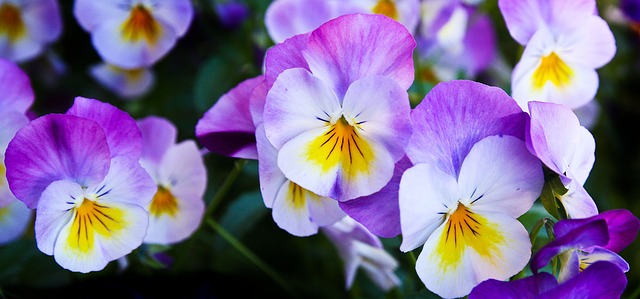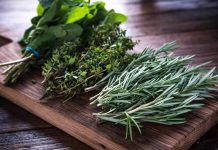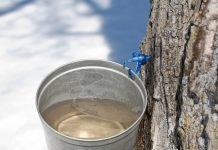Yes, it’s true. While many people grow ornamental plants sheerly for their beauty, many of these plants are also edible. Take a look below and see if you might be growing some ornamental plants you can eat in your yard already.
#1. Hosta (Hosta spp.)
Hostas are adored by gardeners from zone 3 through zone 9 as an easy, adaptable perennial. Their lush, full foliage is their primary feature. They come in a broad range of colors, and their funnel-shaped flowers bloom all summer long, even well into the fall months of September and October.
Hostas can often be found in decorative plantings on either side of the front doorway, as well as in rows along driveways and walkways. Being quite shade-tolerant, they are frequently grown in the shadier areas of flower gardens.
In addition to their decorative appeal, hostas are in the same family as asparagus—and yes, they are edible. Hostas are a common vegetable in Japan, known as giboshi.
While the Montreal Botanical Garden classifies all species as edible (there are about 45), the most popular species for eating are Hosta montana and Hosta sieboldii.
For consumption, hostas are at their prime when they start to emerge in the spring—that is, when the young leaves are furled (they are called hostons). They can be eaten raw in salads or steamed as a veggie, being similar in taste to asparagus.
Related: 20 Edible Plants That Could Save Your Life
Once the leaves open, they are still quite palatable, however, as the leaves get older, they toughen and become more fibrous. Nevertheless, you can still steam them and see if they are to your liking. Or better yet, juice the older leaves along with some of your favorite fruits to make green juice. Other ways of enjoying hostas are adding the chopped leaves to soups and stews, and adding them to green smoothies.
Hosta flowers are also edible. Although nondescript in taste, the pale lavender flowers do add that fairy touch of interest to salads and appetizers. Slugs, snails, and other insects are also hosta lovers, so choose your leaves wisely and wash them well!
#2. Dame’s Rocket (Hesperis matronalis)


You can sometimes find this beauty growing as an escapee, and in some states she is classified as an invasive weed. But this lovely lavender flower is frequently grown as a border plant, too, favored as much for her heavenly scent as for her striking appearance.
She goes by several names, including dame’s wort, dame’s sweet rocket, and summer lilac. But this tall lady with her 4-petalled flowers is a member of the mustard family.
Similar in taste to arugula, her leaves and flowers can be added to salad for an extra kick, and her sweet-smelling flowers are used to bring beauty to the salad bowl.
Feel free to add her leaves to soups and stews; much as you would any other green.
Read More: “Growing Arugula: The Rocket in Your Salad Bowl and Garden (With Recipe)”
Dame’s rocket is hardy from zones 3 through 8. She acts like a short-lived perennial and typically only lives 2 years, but she persists where she grows through prolific self-seeding.
In the south, she blooms in April and May, while in northern states her blooms can last into mid-summer. Deadheading her flowers will help to extend her bloom.
Dame’s rocket looks very much like phlox (Phlox paniculata), and both of them might be growing in a garden at the same time.


Phlox (Phlox paniculata)
You can tell the two apart because dame’s rocket has 4 petals, while phlox has 5. Like dame’s rocket, phlox flowers are edible and have a pungent taste. Try them in fruit salads to add some “bite” and decorative interest.
Related: 8 Edible Backyard Plants And Their Poisonous Lookalikes
#3. Pansy (Viola spp.)


What would summers be without pansies?! These are among the most popular plants sold in nurseries—commonly grown in containers and flower boxes, as well as in the flower garden.
Pansies are sometimes called heartsease, and their smaller cousins are known as Johny Jump Ups. All are in the violet family, and all are edible.
Their taste is kind of like mild wintergreen, and they have a mucilaginous quality. Add their leaves to salads, soups, stews, and smoothies.
Their pretty flowers make delicate, edible ornaments when topping hors d’oeuvres, added to salads, or candied (using egg white and sweetener) to adorn cakes.
Pansies are sun-loving annuals that prefer moist, well-drained soil.
They come in a stunning variety of colors, including red, blue, and white, so have fun planting and eating different colors!
#4. Borage (Borago officinalis)


This star-flowered lady boasts blue flowers on tall, gangly stems. Her young leaves are sweet, cooling, and have a cucumber flavor.
Older leaves become hairy and have a more pungent flavor. If you don’t mind the hairs (some do, some don’t), you can cut the older leaves and add them to salads. Otherwise, add them to soups and stews, or use them like greens in green juices and smoothies.
A real treat is a handful of the dazzling blue flowers, picked off one by one and then gobbled down as a sweet pick-me-up.
You can also freeze each flower in an ice cube tray. When the holidays come around, add them to drinks for an impressive effect.
Borage flowers add flair as a decorative element when placed in salads or when candied (using egg white and sweetener) and used to decorate cakes.
If you don’t use the flowers, they will simply drop to the ground, so do take the opportunity to savor these little nibbles!
Borage is an easy-to-grow annual and self-seeds readily. It blooms from late spring into summer. Because it can get floppy and even topple over, consider staking it.
With a preference for full sun and rich, well-drained soil, borage makes a lovely companion plant for tomatoes, squash, and strawberries. Deadhead flowers for increased blooming, and consider planting several plants at different times for a continual abundance of blooms.
Related: 15 Common Wild Plants You Never Thought Were Edible
#5. Day Lily (Hemerocallis fulva)


Although she is considered a weed in some parts, this orange lady can often be seen flaunting her showy flowers in many a garden. As her name implies, each one of her flowers is open for just one day. While all parts of the plant are considered edible, the leaves—tasting of mild onions—are best eaten cooked when they are 5 inches or shorter and in small quantities. They anodyne and can be hallucinogenic in large quantities.
The opened flowers can be used to add some pizzazz to salads, and can be added to soups and stews to lend a bit of sweetness. You can also stuff them with cooked grains, veggies, pates, and spreads—much as you would use a squash blossom.
Another idea is to dry the petals and then use them as flour in your baked goods. You can do this by removing the petals from the stem and stamens and drying them on parchment-laden cookie sheets, or on a solid sheet in the dehydrator. Let the petals dry completely before grinding them to a flour in a high-speed blender or coffee mill.
The unopened flower buds are prized by many for their taste, and they are especially yummy when sauteed in a stir-fry with noodles and other veggies. They can also be steamed, boiled, pickled, added to soups, eaten raw in salads, and dipped in tempura for frying.
The roots have a nutty taste, and should be white in color—don’t eat the brown roots. While they can be harvested at any time, they are best when eaten in the fall. The seeds are also edible.
Be conservative when eating day lilies. When eaten in excess, they are a laxative.
As with any plant, some people have reported allergic reactions. Start with 1 flower a day to test for sensitivities.
Related: Medicinal Herbs and How to Use Them
#6. Hollyhock (Alcea rosea)


What can be said about this tall lady who conjures images of the English countryside garden? Many have described her flowers as being bland in taste, but I find them to be very pleasing and pleasantly mucilaginous. They certainly make for some showy salads!
The flower buds are also edible and can be added to salads, soups, and stews.
The leaves are edible and can be blanched as you would do to spinach, or chopped and added to stir-fries.
They can also be tossed into the soup or used as wraps: blanch leaves 1-2 minutes, then add in your favorite pate, spread, cooked grain or rice, and roll up. Their bland “green” taste means you can try adding them with fruits into green smoothies and juices.
The fully mature brown or blackish seeds are also edible. Wait until the stem attached to the seed pods begins to turn brown and the papery shell encasing the seed pods is yellowed. Cut the pods from the stem, then let fully dry. Eat as-is, grind and sprinkle over cereal, or add to muffin and bread recipes.
The roots are also edible and contain vitamins B and C, as well as calcium and many trace minerals, including copper, zinc, and iron. They are best added to soups and stews. You can also dry the root and decoct it as you would marshmallow root tea to help soothe and rebuild an inflamed intestinal mucosa.
Hollyhocks are easy to grow and they self-seed readily. Because of their height (as high as 9 feet or more), they do well in the back of a border with support such as a fence, wall, or stake. They need lots of room (space them 18-24 inches apart), and they prefer moist, well-drained soil. In colder areas they act as short-lived perennials or biennials. They are hardy from zones 3 through 8, and they come in a plethora of colors, so have fun growing and experimenting!
Related: 8 Plants That You Need To Know How To Harvest Seeds From
#7. Creeping Bellflower (Campanula rapunculoides)


Creeping Bellflower by Zeynel Cebeci; CC BY-SA 4.0
While some consider creeping bellflower to be a highly invasive “weed,” as it self-seeds most readily and even a tiny fragment of its root will spawn a new plant, others find that its pale lavender flowers adorning tall stems are a welcome ornamental plant.
If you have thought about pulling it out of your garden, you might want to reconsider, since this lovely lady is edible. When young, the shoots can be blanched and eaten like asparagus. Her leaves can be added to soups or stews or blanched as you would any green. Her flowers are also edible, and they add interesting appeal to any salad.
Her real treasure is in her root, which tastes like parsnip.
Dig up some roots in the fall, and wash, peel, and boil them as you would parsnip. If you’ve never tried this before, a good idea is to boil parsnip at the same time you are cooking bellflower root. Taste each one to compare their differences. I’ve boiled equal amounts parsnip and bellflower and whipped them in a blender with some oil and salt to make parsnip potatoes. You’d never know there was bellflower root in there!
#8. Nasturtium (Tropaeolum)


Nasturtiums are plants that are grown easily from seeds. Their red, gold, and yellows are lovely in flower boxes, as ground cover for borders and edges, or hanging from baskets or trailing down a fence.
They have a peppery taste, similar (some say) to radishes. They add delightful zing and attractive appeal to salads.
You can also use them to add some sass to veggie juices and smoothies, or add them to your soups and stews, where their sharp taste will blend in.
Instead of using crackers in appetizer recipes, consider using nasturtium leaves. Their tangy bite pairs nicely with sweet fruits like cherries and pineapple, and with mild (or even vegan) cheese. The seeds are also edible, and are often pickled and eaten like capers.
Like pansies, nasturtiums enjoy well-drained soil and full sun. They are considered annuals, although some varieties act as perennials in zones 9 through 11. They are easy to grow and they typically bloom in the summer and fall months. Don’t fertilize during their growing season, as this encourages more foliage.
They make excellent companion plants for radishes, tomatoes, and cucumbers.
Related: The Edible Backyard Harvest You Never Knew Existed
#9. Chrysanthemum (Chrysanthemum spp.)

Yes, mum’s the word: mums are edible! While the yellow and white flowers are used as a tea in Chinese medicine to help with liver issues, these quintessential fall flowers add a pungent taste to salads. Feel free to experiment with other colors, as mums come in a dizzying array of reds, oranges, pinks, and purples.
The leaves are great to use in stir-fries, and can be added to soups and stews as you would any green. You can also juice the leaves or use them in green smoothies in small amounts. They also freeze and dry well for later use, and you can even grind the dried leaves into a flour to add some extra nutrition to your bread recipes.
There are countless cultivars and varieties of mums to choose from. Would you like a dwarf or a giant? Perennial or annual? Early- or late-blooming flowers? All mums, however, prefer full sun and well-drained sandy or loamy soil.
Related: Edibility Test: Find Out Which Backyard Weeds are Edible
Other Edible Ornamental Plants
There are, of course, many other edible ornamental plants that we haven’t discussed here. In fact, you could say that these 9 plants represent but a small sampling of all the edible (and medicinal) plants commonly found in our flower gardens and landscapes!
Here are a few other plants you may be growing already that have edible and medicinal qualities:
- Edible Flowers: Forget-me-nots, begonias (including wax begonias), ox-eye daisies, tulips (petals)
• Edible Leaves: Hyssop, lemon balm, lemon verbena, Chinese skullcap
• Medicinal Properties: Bupleurum (root), peony (root), echinacea (root), feverfew (leaf and flower)





















